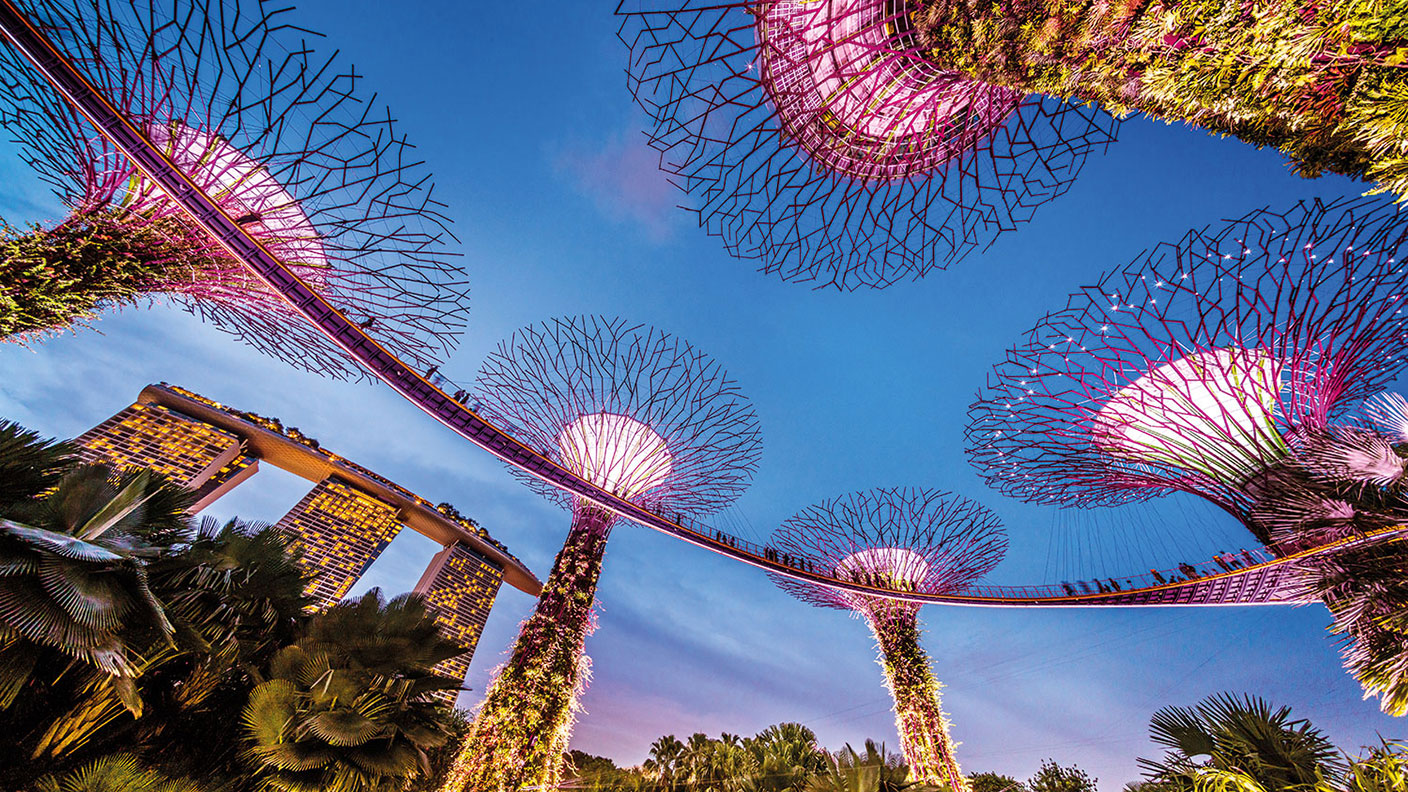The recipe for economic growth
Long-term development isn’t a linear progression: many countries get stuck in the middle-income trap. What do they have in common and how might they escape? Jonathan Compton explains.

I am offering my services for a ridiculously modest fee to any poor country keen to double the size of its economy in real (inflation-adjusted) terms over the next 11 years. That means GDP growth of 6.5% a year. For the first five years, I require no payment; then perhaps a tiny 0.1% of GDP for each of the last six years.
There is no great mystery in how to make a low-income economy boom. Ideally, start with a young population, because the old tend to become a state expense and hoard money, hampering GDP growth. Then move most of those people working on the land to the cities (tourist brochures showing charming paddy fields with workers bent double are exemplars of low value-added – the products add little to the economic pile).
Next, allow women to work. Wherever female participation rates have soared so too has the economy. The rate in America doubled to 66% in the 30 years to 1980, its golden era. Add widely available and cheap contraception and half of the workforce has more time to be productive. Wherever women have the choice they have fewer children, which is why over the last 60 years the average global birth rate has fallen from five children per woman to 2.4.
MoneyWeek
Subscribe to MoneyWeek today and get your first six magazine issues absolutely FREE

Sign up to Money Morning
Don't miss the latest investment and personal finances news, market analysis, plus money-saving tips with our free twice-daily newsletter
Don't miss the latest investment and personal finances news, market analysis, plus money-saving tips with our free twice-daily newsletter
This pattern has allowed many countries to become less poor. The next phase ideally includes minimum expenditure on defence, given its low economic impact; throwing money at infrastructure (especially power, roads and ports); and mass production by semi-skilled workers. To make an economy work at this stage, money spent on education or welfare is a waste. Workers’ and other rights pose a distinct disadvantage; nor is democracy a particularly helpful ingredient.
The early movers
The formula worked well for the very early movers – England especially, France and Holland at the start of the 19th century, America, Japan and Germany at the end. The latter quarter of the 20th century saw the rise of the Tiger economies in Asia (and a few cubs globally). These four Tigers – South Korea, Taiwan, Hong Kong and Singapore – became role models of how to escape poverty. For two decades Hong Kong and Singapore have enjoyed higher real disposable income per capita than their one-time coloniser, the UK.
Yet at the time this success was unexpected. The great hope in East Asia was the Philippines, with the second-highest literacy rate after Japan and good (US-built) infrastructure. Even Singapore’s founding father Lee Kuan Yew in his early political career aspired only for his country to catch up with Sri Lanka in terms of income per head. Today it is 15 times greater.
These Tigers also enjoyed less visible benefits. America provided the defence umbrella. Relative wage rates were very low, world trade was booming and tariffs were being dismantled. Many now developed countries also benefited from foreign direct investment (FDI) to provide capital for long-term projects such as docks or railroads (the Tigers, however, generated most of this internally).
With hindsight, the surprise is not that these countries broke through into moderate, then high-wealth status, but how few other countries have managed to achieve this. Countries caught in the halfway house between poverty and wealth are known as being caught in the “middle-income trap”.
Definitions of how this is measured vary considerably and all are clunky. I use a common benchmark – “adjusted net national income per capita in constant 2010 dollars of between $9,000 to $13,000” – because the data provides good comparisons. Yet this must be qualified, as much of it is little more than guesswork. Not only are many GDP measures poorly collated or completely made up (as in the old USSR or China today), but they fail to capture the huge role of the black market, which in countries such as Mexico or Russia is thought to be over 40% of GDP and 20% in Greece and Italy.
An exclusive club
In 1960 there were an estimated 101 countries in the middle-income trap (MITs). Of these less than 15 had broken out by 1990; by 2019, only 20. Thus the majority of MITs are locked in the waiting room where most are now doomed to remain. Some will even regress. To advance from poverty to MIT is relatively easy. To become a developed economy requires dramatic changes, almost to the extent of tearing up earlier, successful plans.
MITs stall for many reasons. The cheap labour advantage is eroded by rising domestic wages and undercut by poorer countries. Many national success stories started in textiles, plastics and low-end manufacturing. But the next phase requires greater value-added and complexity – vehicles, high tech, aeroplane parts and ships.
These demand a better-educated and more flexible workforce, which implies a large increase in government expenditure. Here the black market becomes relevant. No country where the black market accounts for more than 20% of GDP has been able to make this transition. Developed economies are not morally superior, but need to be cleaner to stay at the top.
Higher wages and better education create their own dynamic, but also lead to a surge in welfare demands. Many MITs fail at this stage. The tax base is insufficient because of the black market and corruption. In early development corruption can be beneficial: the big cheese bribes the leaders to allow him to build factories and roads. The few labour or environment laws or individual rights are weakly enforced. Hong Kong’s success grew out of textiles where all these factors applied.
Many countries have enjoyed rapid growth up to MIT status with a handful of family businesses running the show in a cosy club with money-hungry politicians. It works for a while. It took five years from 1835 to build the London to Bristol Great Western Railway. Many of us will be six feet under by the time HS2 is finished. Yet as economies advance they become more complex, so a transparent legal system with an independent judiciary is vital to referee competing interests. So yes, for all its flaws a form of genuine representative rule is required.
Populist autocrats are a major disadvantage
Permanent members of the MIT club tend to share certain characteristics. One is having the same leader in power for over a decade, or the same party for even longer. Examples include Argentina, Brazil, Malaysia and Turkey. In downturns these leaders resort to populism and handouts to supporters. Another hallmark is low investment rates in capital plant and machinery, or in research and development, where MITs spend proportionally less than a third compared with developed countries. Then there is inequality. The Gini coefficient measures how widely wealth is spread: zero represents absolute equality (20th-century communist experiments proved that zero created near universal misery); 100 represents total inequality.
Most developed countries are between 28 and 38; they have a broad consumer base. MIT countries score much higher. The four countries mentioned above, along with Colombia, Mexico, South Africa, and Thailand fall come into this category. Finally there is “leakage”: the fear of seizure by government results in much needed capital at home being squirrelled into offshore sanctuaries – witness the hefty Russian and Chinese ownership of London’s skyline.
Global money flows avoid trouble spots
These problems mean that many MITs are largely ignored by two overlapping sources of money that otherwise can turbocharge an economy: foreign direct investment (FDI) and multinational corporations (MNCs). FDI can be passive – you and I buy shares in a country’s bonds or equities because we think they look a good long-term investment. MNCs are even more opportunistic. Their investment goes to the country offering the best longer-term bang for their buck; it takes time to get money back from building a factory.
They know “unbeatable deals” from national governments are too good to be true. They want stability. In February I visited Uruguay’s largest business, a giant, Finnish-owned paper mill on the River Uruguay. On the other side is Argentina. It had offered the company knockout terms, but after politicians and businessmen from each municipality, district and central government had demanded their cut, Uruguay came in at half the price.
Three winning characteristics
MIT escapees fall into three broad groups: countries with tight social cohesion (Japan, South Korea and Taiwan); those that have accepted external rules and constraints (Greece, Ireland, Portugal or Spain); and nations with fewer than around eight million people who feel threatened: the Baltics, Israel, Finland and Singapore.
The problems facing MITs today are stark. The key drivers are stalling. Growth in world trade has been slowing for nearly a decade while barriers and tariffs have been rising. As a result MNCs tend to invest less in these developing nations while FDI is being diverted to safer homes (the largest European recipient of the last decade was the UK). There is excess capacity in many industries. Most important is demographics. The growth rate of the global population has been falling since the 1980s with the birth rate below the replacement rate in diverse countries. The populations of Japan, Italy, France and China are all ageing rapidly, with the attached costs and loss of production. The easy gains have been had; structural reforms have stalled.
This matters to investors because the MIT club and its wannabe members comprise over half the world’s population. If they turn sour we are all affected. Progress in North Africa and the Middle East has ceased. In Latin America the likely winners such as Chile and Uruguay are economic minnows. Forget Russia, while in Asia the dreams of a modern India are turning to dust. Populous countries such as Indonesia are about to reverse, while even the once safe bets of Malaysia and Thailand look economically iffy.
China remains a conundrum. Acute awareness of the MIT trap – hence its successful policy on infrastructure, investment, research and domestic consumption – is offset by bad demographics, legal and ruling systems. It could go either way, but from an economic point of view and longer term for their stockmarkets, the future for these MIT economies seems far from bright.
• Jonathan Compton worked in investment banking and asset management for 35 years and now writes and lectures on financial markets as well as managing some pubs and farms. (jlcompton@outlook.com)
Get the latest financial news, insights and expert analysis from our award-winning MoneyWeek team, to help you understand what really matters when it comes to your finances.
Jonathan Compton was MD at Bedlam Asset Management and has spent 30 years in fund management, stockbroking and corporate finance.
-
 What are my retirement income options?
What are my retirement income options?We’re all told to save into a pension, but there’s widespread confusion about how to take an income from our savings and investments at retirement, a new study has found. We look at your retirement income options.
-
 UK interest rates: will the Bank of England lower rates?
UK interest rates: will the Bank of England lower rates?The Bank of England’s Monetary Policy Committee’s (MPC) final interest rates meeting of the year takes place tomorrow (18 December) and most experts expect a cut
-
 Renewable energy funds are stuck between a ROC and a hard place
Renewable energy funds are stuck between a ROC and a hard placeRenewable energy funds were hit hard by the government’s subsidy changes, but they have only themselves to blame for their failure to build trust with investors
-
 The war dividend – how to invest in defence stocks as the world arms up
The war dividend – how to invest in defence stocks as the world arms upWestern governments are back on a war footing. Investors should be prepared, too, says Jamie Ward
-
 Did COP30 achieve anything to tackle climate change?
Did COP30 achieve anything to tackle climate change?The COP30 summit was a failure. But the world is going green regardless, says Simon Wilson
-
 Rachel Reeves's punishing rise in business rates will crush the British economy
Rachel Reeves's punishing rise in business rates will crush the British economyOpinion By piling more and more stealth taxes onto businesses, the government is repeating exactly the same mistake of its first Budget, says Matthew Lynn
-
 Leading European companies offer long-term growth prospects
Leading European companies offer long-term growth prospectsOpinion Alexander Darwall, lead portfolio manager, European Opportunities Trust, picks three European companies where he'd put his money
-
 How to capitalise on the pessimism around Britain's stock market
How to capitalise on the pessimism around Britain's stock marketOpinion There was little in the Budget to prop up Britain's stock market, but opportunities are hiding in plain sight. Investors should take advantage while they can
-
 London claims victory in the Brexit wars
London claims victory in the Brexit warsOpinion JPMorgan Chase's decision to build a new headquarters in London is a huge vote of confidence and a sign that the City will remain Europe's key financial hub
-
 Reinventing the high street – how to invest in the retailers driving the change
Reinventing the high street – how to invest in the retailers driving the changeThe high street brands that can make shopping and leisure an enjoyable experience will thrive, says Maryam Cockar